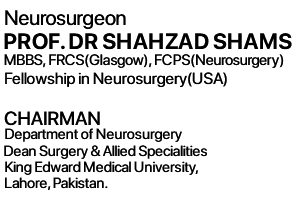Prof. Shahzad Shams presently works as Head and Professor of the Neurosurgery Department at Lahore General Hospital, LGH, Lahore.
Endoscopic Minimally Invasive Keyhole Surgery for Spinal Cord Compression
(Caries &Tumors)
General Features
Spinal compression, whatever its cause, demands surgical relief. Even when the cord has been distorted and compressed for years function may return to a surprising degree if the compression is relieved. Cervical compression shows most clearly the combination of radicular and cord signs, because failure of function of the roots at this level is immediately evident to the patient in the muscles of the arm and hand.
The level of the sensory loss due to cord involvement is commonly several segments lower than expected and sacral sensation may be spared although the lesion appears to be otherwise complete. Thoracic compression presents as a cord lesion with a clear-cut sensory level in the expected situation; radicular involvement is limited to girdle pain. Lumbar lesions are predominantly radicular because the cord ends about the interspace between vertebral bodies L1 and 2, below which only the roots of the cauda equine are affected.
Flaccid paraplegia with absent reflexes is associated with radicular sensory loss and an atonic bladder. High lumbar lesions may affect also the upper motor neurons of the sacral segments in the conus medullaris, making for a mixed clinical syndrome with absent tendon reflexes and the plantar responses (if still active) extensor.
Neurogenic claudication is caused by compression of the cauda equine in a narrow lumbar spinal canal. It consists of paraesthesiae, numbness, or weakness developing consecutively after a certain amount of exercise; there may also be some calf pain. In most instances a compression lesion is found; this may be a central disc protrusion or a congenital or acquired narrowing of the bony canal; the mechanism is uncertain.
Treatment
Endoscopic Minimally Invasive Keyhole Surgery
Immediate surgery is the answer and it involves removing the cord compressing pathology and if massive damage of the vertebra is involved then spinal fixation with titanium screws and plates or cage fixation is also required in few cases.







